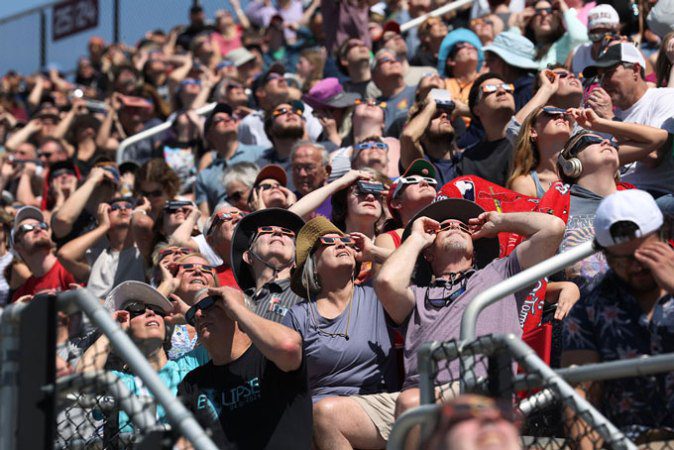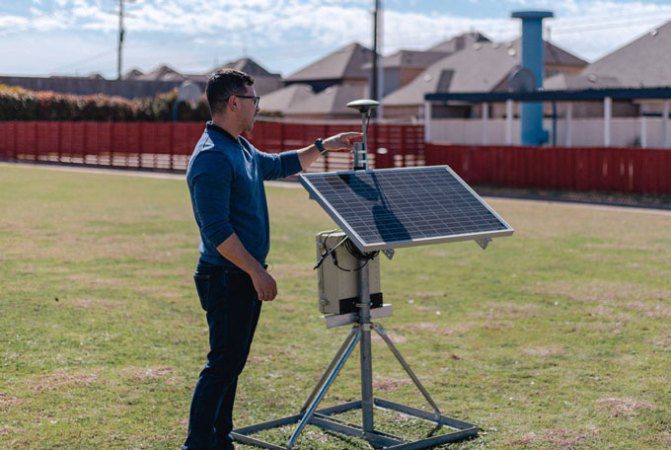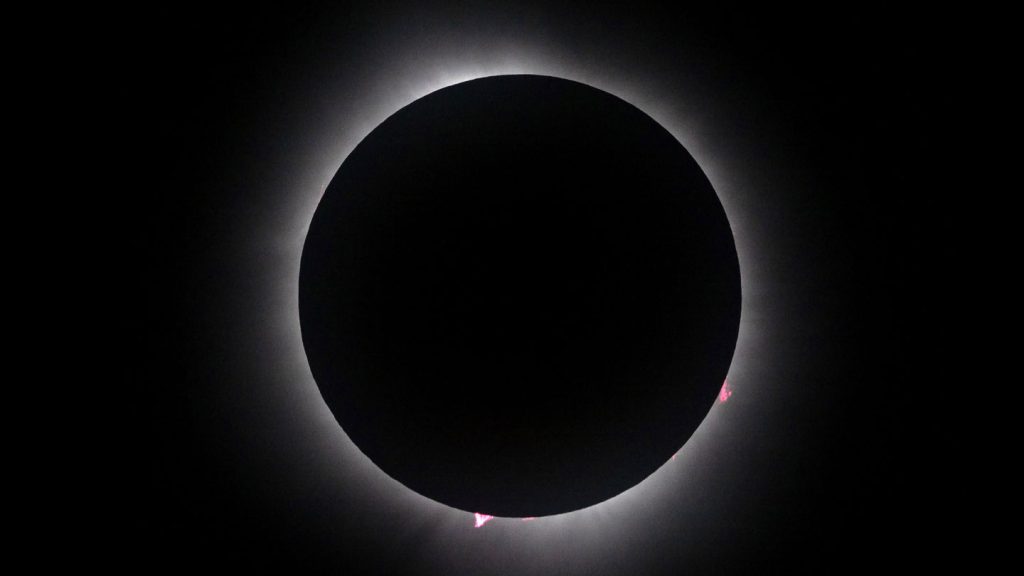WILLS POINT, Texas — Splish-splash. The moment the sun went behind the moon, the snapping turtles all simultaneously slipped into the waters of Lake Tawakoni. Twilight painted the world. Clouds raced across the sky. Just beside the moon-covered sun sat bright Jupiter, shining in the middle of the day. Most birds and insects had grown hushed or gone completely silent.
It’s difficult to fully capture the feeling of a total solar eclipse; how it alters the type of the light in your surroundings, how the temperature drops so suddenly that you unexpectedly shiver (SN: 4/1/24). But on April 8, I and millions of people across North America got to witness a celestial wonder.
I’d ventured to Wills Point, about an hour east of Dallas, to meet up with Darci Snowden, a space physicist at Central Washington University in Ellensburg and her undergraduate students. From a wooden pier, they were sending up weather balloons to capture data, delighting local families who gathered to watch the balloons ascend into the sky.
For days leading up to the eclipse, the forecast in Texas had been poor, with potential thunderstorms and cloud cover blocking the skies. When things finally shook out, we had a nice long period of cloudless sky as the moon moved in front of the sun, turning it into a slim crescent. Just at the moment of totality, a large cloud came by, leading to groans all around. Luckily, the sun’s usually invisible atmosphere, the corona, broke through patches in the clouds. Tiny red dots could be seen at the sun’s edges — fiery flares erupting from its surface.
Cloudy or clear, there was still science to be done. Total solar eclipses provide rare opportunities to study the sun and its impact on Earth in unprecedented ways.
Here in Wills Point, starting at 2 p.m. CDT the day before the April 8 eclipse, Snowden’s team began launching a series of 30 weather balloons. The plan was to send up one every hour, all through the night, continuing for six hours after the eclipse. Buoyed by helium, these balloons are capable of soaring to a height of 33 kilometers (20 miles) into the stratosphere, the atmosphere’s second-lowest layer. They carried battery-powered instrument packages called radiosondes to gather such data as temperature, humidity, pressure, and wind direction and speed.
Snowden and her students hope to get detailed information on how an unusual event like a total solar eclipse affects Earth’s atmosphere. They are studying what happens in the atmosphere’s lowest region, known as the planetary boundary layer, which reaches a height of around two kilometers and blankets Earth’s surface. Changes in this layer are driven by two things: the geography of the ground, including objects such as mountains, buildings and forests; and solar radiation raining down from above.
The team is searching for proof of gravity waves, which are different from gravitational waves. Gravity waves are a phenomenon on Earth and can be caused by air being forced upward by something like a mountain and then pulled back down by gravity. They can also be triggered by rapid temperature changes, causing cool air to sink and then rise back up, creating a wave.
Snowden explains that it's similar to pushing down an ice cube in a glass of water.
In 2017, scientists flew balloons outside the shadow of the total solar eclipse in Wyoming and New York. They found evidence that the moon's shadow caused gravity waves close to the ground, as predicted 50 years earlier. They also spotted gravity waves higher in the atmosphere during the same event. They observed gravity waves being created by the eclipse. Gravity waves close to the ground moved outward like bow waves from a ship during the 2017 eclipse. For the first time, eclipse-driven gravity waves were also seen higher up in the atmosphere during this event. During this eclipse, Snowden aims to confirm the previous hints of gravity waves in lower atmospheric layers. (SN: 4/30/18).
The goal of launching balloons 24 hours before the eclipse was to gather baseline readings before the event, which can be compared to measurements taken during and after the eclipse.
Data from these experiments could improve short-term weather and long-term climate predictions. Although gravity waves are small, they have significant effects on turbulence, heat transfer, and the mixing of airborne chemicals across the planet. They can travel long distances and break like ocean waves high above the Earth.
Launching the team's weather balloons just before and after the eclipse was stressful, but once they started, everything went smoothly.
The students' data will be combined with information from around 40 other teams involved in the Nationwide Eclipse Ballooning Projectby NASA. It will take about a year to process and analyze the data to determine if the eclipse produced gravity waves in the lower atmosphere.
Various eclipse-related experiments were conducted by different organizations and groups of citizen scientists across the country. Crowds gathered in towns across the path of totality to witness the eclipse, hoping for a clear view of the celestial phenomenon. researchers and groups of citizen scientists were conducting eclipse-related experiments all over the country, while crowds gathered in towns across the path of totality to view the celestial phenomenon.SN: 10/18/23; SN: 1/4/24).

Physicist Fabiano Rodrigues and his team at the University of Texas, Dallas campus were observing the ionosphere, which starts about 80 to 90 kilometers above the surface.
The thin atmospheric gases in this layer are bombarded by solar radiation, breaking their atoms into electrons and nuclei, a process known as ionization. At night, when not affected by solar activity, these ions have an opportunity to recombine. Similar changes occur during the sudden darkness of a total solar eclipse.
To monitor the ionosphere, Rodrigues and his students placed affordable devices capable of receiving satellite signals, such as GPS, in a large triangle: one on campus, one approximately 100 kilometers north, and the third about 50 kilometers east in the town of Terrell. live increase and decrease of electron content in the ionosphere, an indicator of its level of ionization.
The data collected by Rodrigues and his team during the eclipse could verify predictions about how much the ionosphere will deionize due to the loss of sunlight from the eclipse, or where these predictions fall short. This information will be used to understand how changes in the ionosphere impact and degrade satellite transmissions, crucial for communication and navigation, so that engineers can address these impacts in the future.

According to Rodrigues, electron counts in the ionosphere decreased as anticipated during the event, although it will likely take a few days to determine which models provided the most accurate predictions. Despite some cloud cover in Dallas, he's very happy with the outcome.
Meanwhile, as the sun returned to normal levels above Lake Tawakoni, Snowden and her team were able to take a moment to reflect on what they had just seen before resuming their balloon launches.
“It’s an incredible experience,” she remarks. “And I feel very lucky to have witnessed it.”



